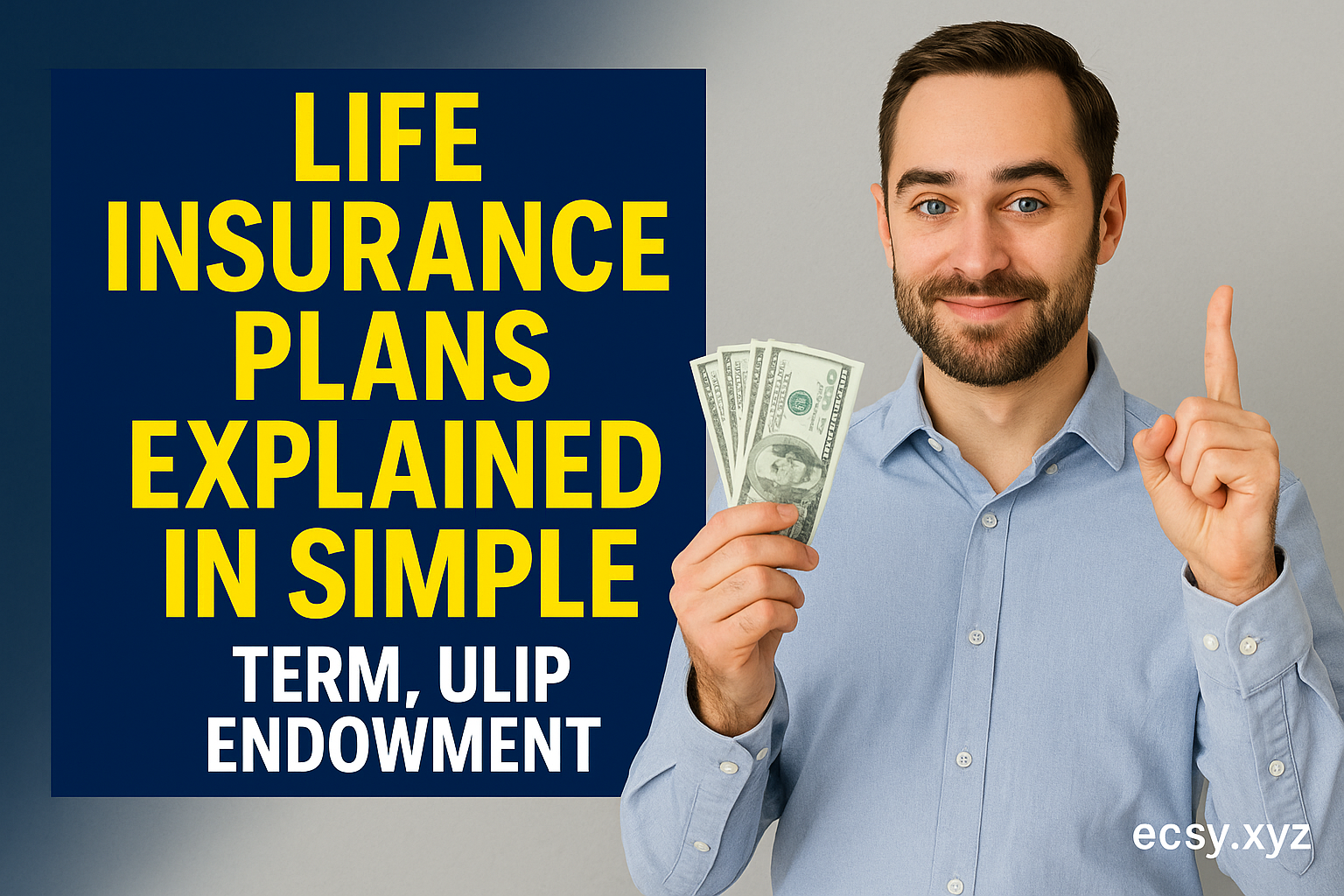Understanding life insurance plans is crucial when planning for financial security. Whether you’re safeguarding your family’s future or building long-term wealth, choosing the right life insurance can make a lasting impact. In this guide, we will break down the three major types of life insurance policies – Term Insurance, ULIPs (Unit Linked Insurance Plans), and Endowment Plans – in the simplest terms possible, so you can make informed, confident decisions.
What is Life Insurance?
Life insurance is a contract between you and the insurance company, where the insurer promises to pay a designated sum (called the sum assured) to your beneficiary upon your death, in exchange for regular premium payments. Depending on the plan, it may also include survival or maturity benefits, investment components, or both.

Types of Life Insurance Plans
Life insurance plans are broadly categorized into the following three types:
1. Term Insurance – Pure Protection at Its Best
Term life insurance is the most straightforward and affordable type of life insurance. It provides pure life coverage with no savings or investment component.
Key Features:
-
Low Premiums: Term plans offer high coverage at relatively low premiums.
-
Fixed Policy Term: Coverage is valid for a fixed number of years (10, 20, 30 years, etc.).
-
Death Benefit Only: If the policyholder dies during the policy term, the nominee gets the sum assured. If the policyholder survives the term, there is no payout (unless a return of premium option is selected).
-
Optional Riders: You can enhance your coverage with riders like accidental death, critical illness, and disability benefit.
Ideal For:
-
Young professionals and families looking for high coverage at a low cost.
-
Primary breadwinners who want to secure their family’s financial future.
2. ULIP – Life Cover with Market-Linked Returns
ULIP (Unit Linked Insurance Plan) is a hybrid product that combines life insurance with investment opportunities. A part of the premium is allocated to provide life cover, while the remaining is invested in equity, debt, or balanced funds.
Key Features:
-
Dual Benefits: Offers both insurance and investment in one plan.
-
Flexible Fund Options: You can switch between equity and debt funds based on your risk appetite.
-
Market-Linked Returns: Returns depend on market performance.
-
Lock-in Period: ULIPs have a minimum 5-year lock-in period.
-
Tax Benefits: Eligible for deductions under Section 80C and tax-free maturity under Section 10(10D), subject to conditions.
Ideal For:
-
Individuals with a medium-to-long-term investment horizon.
-
Those looking for wealth creation along with life coverage.
3. Endowment Plan – Guaranteed Returns with Protection
An Endowment Plan is a life insurance policy that combines savings and insurance. It pays a lump sum either on death or on maturity, whichever occurs first.
Key Features:
-
Guaranteed Returns: Provides a fixed maturity amount along with bonuses.
-
Low to Moderate Risk: Ideal for conservative investors seeking safe returns.
-
Savings Discipline: Encourages long-term savings through regular premium payments.
-
Death and Maturity Benefits: Offers a sum assured to the nominee on death and the policyholder receives the maturity benefit if they survive the term.
Ideal For:
-
Individuals with low risk tolerance.
-
Those who need financial discipline to save for future goals like education, marriage, or retirement.
Comparison Table: Term vs ULIP vs Endowment
| Feature | Term Insurance | ULIP | Endowment Plan |
|---|---|---|---|
| Purpose | Pure protection | Insurance + Investment | Insurance + Savings |
| Premiums | Lowest | Moderate to High | Moderate |
| Returns | None | Market-linked | Fixed + Bonuses |
| Risk Level | None | Depends on market | Low |
| Lock-in Period | None | 5 Years | 2-3 Years |
| Flexibility in Funds | Not Applicable | High | Low |
| Maturity Benefit | No (unless return option) | Yes | Yes |
| Tax Benefits (80C/10(10D)) | Yes | Yes | Yes |
Which Life Insurance Plan Should You Choose?
Your choice of life insurance should depend on your life stage, goals, and risk appetite:
-
If you’re a young professional with dependents and limited budget: Term Insurance is the best option.
-
If you’re aiming to grow wealth while staying insured: Choose a ULIP.
-
If you’re looking for guaranteed returns and insurance combined: Go for an Endowment Plan.
How to Select the Right Life Insurance Policy
To make the best choice, consider the following steps:
-
Assess Your Needs: Understand the financial needs of your dependents.
-
Determine Coverage Amount: Ideally, your sum assured should be 10–15 times your annual income.
-
Compare Plans: Use online tools and compare premium, benefits, and riders.
-
Check Claim Settlement Ratio: Always choose insurers with a high claim settlement ratio.
-
Read the Fine Print: Be clear about exclusions, lock-in periods, charges (for ULIPs), and policy terms.
Common Mistakes to Avoid
-
Underinsuring Yourself: Don’t choose low coverage to save on premium.
-
Ignoring Riders: Riders like critical illness or waiver of premium can be extremely helpful.
-
Choosing Wrong Plan Type: Don’t buy an endowment or ULIP thinking it’s the best just because it offers returns. Match it with your goal.
-
Lack of Periodic Review: Review your life cover every few years, especially after major life events (marriage, childbirth, buying a house).
Tax Benefits of Life Insurance
All life insurance policies are eligible for deductions under Section 80C up to ₹1.5 lakh per year. Additionally, maturity proceeds are tax-free under Section 10(10D) if the premium is not more than 10% of the sum assured.
ULIPs launched after 1st Feb 2021 with annual premiums above ₹2.5 lakh are not eligible for tax-free maturity under 10(10D), so plan accordingly.
Final Thoughts
Choosing the right life insurance plan is not just about securing your life, but also about ensuring financial stability for your loved ones. Whether it’s pure protection, market-linked growth, or guaranteed savings, understanding these plans helps you make an informed decision that aligns with your financial goals.
Make life insurance a core part of your financial portfolio today.
Real-Life Scenarios: Which Life Insurance Plan Works Best?
To help you better understand which plan is suitable for your needs, let’s explore a few real-world examples.
Scenario 1: A 30-Year-Old IT Professional with a Young Family
Ravi, an IT engineer earning ₹12 lakhs annually, wants to ensure his family’s financial stability in case something happens to him. He chooses a term insurance plan with a ₹1.5 crore cover at a yearly premium of just ₹12,000.
✔️ Affordable
✔️ High protection
✔️ Tax saving under Section 80C
Scenario 2: A 35-Year-Old Business Owner Seeking Wealth Creation
Anjali, a businesswoman, is financially secure but wants to invest in market-linked products while having life coverage. She opts for a ULIP, investing ₹1.5 lakhs/year for 10 years in a high-growth equity fund.
✔️ Dual benefit of life cover + wealth creation
✔️ Fund switch flexibility
✔️ Long-term capital appreciation potential
Scenario 3: A 40-Year-Old Teacher Planning for Child’s Education
Mr. Sharma, a school teacher, prefers safety and guaranteed returns. He invests in an endowment plan to ensure a corpus when his child turns 18.
✔️ Assured maturity benefits
✔️ Death coverage during the policy term
✔️ Bonus additions improve returns over time
Riders That Can Enhance Your Life Insurance Coverage
Riders are add-ons that you can purchase with your base insurance policy for an additional premium. These offer extended protection in specific scenarios.
Most Common Life Insurance Riders:
-
Accidental Death Rider: Pays an extra sum if death is due to an accident.
-
Critical Illness Rider: Pays a lump sum upon diagnosis of listed illnesses like cancer, stroke, etc.
-
Waiver of Premium: Waives future premiums if you become disabled or critically ill.
-
Income Benefit Rider: Provides regular monthly income to your family in case of your death.
Including the right rider can make a significant difference in your financial safety net.
Understanding Bonuses in Endowment Plans
One of the key attractions of endowment plans is the bonus structure offered by insurers. These bonuses enhance your maturity value and are declared annually.
Types of Bonuses:
-
Reversionary Bonus: Declared yearly and added to your sum assured.
-
Terminal Bonus: A one-time bonus paid at maturity or death, if applicable.
-
Cash Bonus: Paid out in cash annually instead of being added to the sum assured.
The actual bonus depends on the performance of the insurance company and is not guaranteed unless explicitly mentioned.
Charges Associated with ULIPs
While ULIPs offer high potential returns, they come with certain charges that can affect your gains if not understood correctly.
Common ULIP Charges:
-
Premium Allocation Charge: A portion of your premium goes towards this before investment.
-
Policy Administration Charge: Deducted monthly for maintaining the policy.
-
Fund Management Charge: A fee for managing your investment funds.
-
Mortality Charge: Cost of providing the insurance cover.
-
Fund Switching Charge: Some insurers allow limited free switches; extra switches may cost extra.
Understanding these charges helps you maximize your returns and choose the best ULIP for your goals.
How Much Life Insurance Do You Really Need?
A critical question most people overlook is how much cover is actually sufficient.
Rule of Thumb:
Aim for 10 to 15 times your annual income, plus cover any major liabilities like loans, mortgages, or children’s education expenses.
Comprehensive Coverage Formula:
This formula helps ensure your family won’t face financial hardship in your absence.
Buying Life Insurance Online vs Offline
With the digital boom, buying life insurance online is now more common and convenient.
Online Insurance:
-
Lower Premiums due to reduced overhead costs
-
Easy comparisons across insurers
-
Instant policy issuance
Offline Insurance (via agents or advisors):
-
Personalized advice
-
Help with paperwork and follow-up
-
Suitable for first-time or senior buyers needing hand-holding
Each has its pros and cons, but digital-first buyers usually benefit more from online plans due to cost efficiency and flexibility.
Frequently Asked Questions (FAQs)
Q1: Can I buy multiple life insurance policies?
Yes, you can. Many people maintain a term plan for protection and an endowment or ULIP for savings/investment. The combined coverage must be justifiable based on income and liabilities.
Q2: What happens if I stop paying the premiums?
If you stop paying premiums:
-
Term plans lapse, and coverage ends.
-
ULIPs may go into a grace period or be converted to a paid-up policy.
-
Endowment policies may acquire a surrender value if a minimum number of premiums have been paid.
Q3: Is a medical test mandatory for life insurance?
Not always. Some plans offer no-medical options for lower sums assured, but high-value covers often require medicals for underwriting accuracy.
Q4: Is life insurance a good tax-saving instrument?
Yes, premiums paid qualify for deductions under Section 80C, and maturity benefits are generally exempt under Section 10(10D), depending on conditions.
Conclusion
Choosing the right life insurance plan is not one-size-fits-all. Whether your priority is protection, investment, or savings, there’s a policy tailored to your specific needs. By understanding the differences between Term Insurance, ULIPs, and Endowment Plans, you empower yourself to make wise, future-proof financial decisions.
Start early. Choose smart. Revisit regularly.
Because when it comes to securing your loved ones’ future, nothing beats a well-planned life insurance policy.

